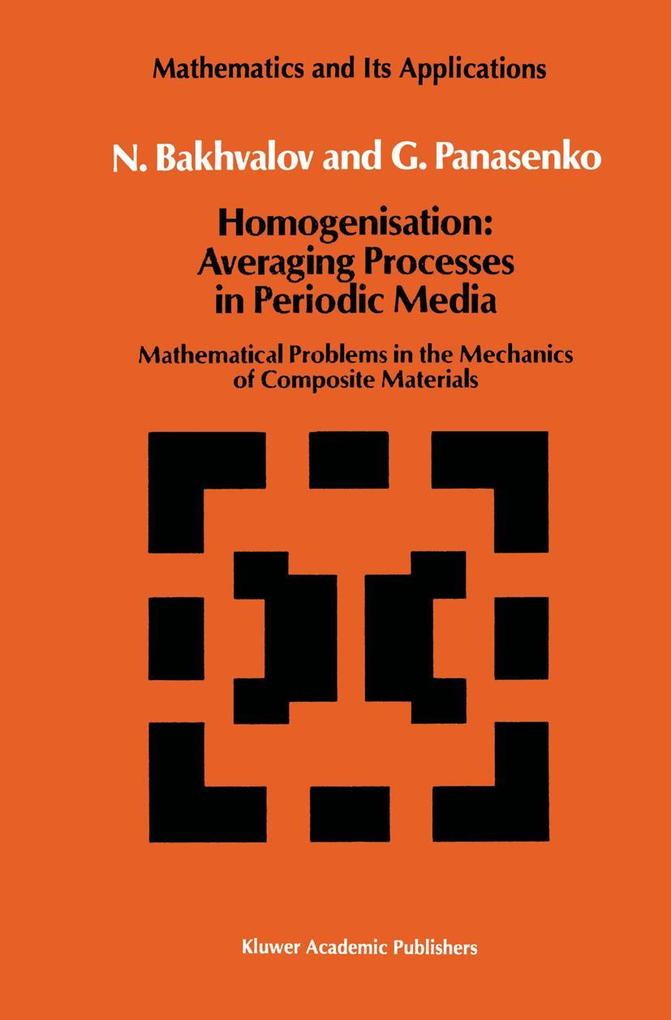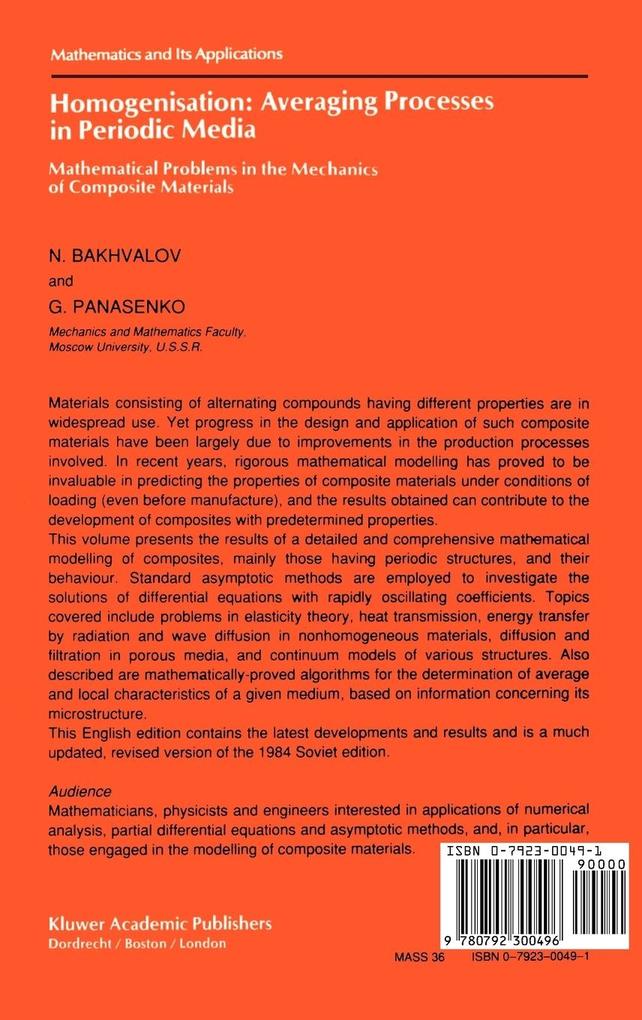
Zustellung: Mi, 23.07. - Sa, 26.07.
Versand in 7 Tagen
VersandkostenfreiBestellen & in Filiale abholen:
'Et moi, . . . . si j'avait su comment en revenir, One service mathematics has rendered the je n'y semis point all, , : human race. It has put common sense back Jules Verne where it belongs, on the topmost shelf next to the dusty canister labelled 'discarded non The series is divergent: therefore we may be sense'. able to do something with it. Eric T. Bell O. Heaviside Mathematics is a tool for thought. A highly necessary tool in a world where both feedback and non ! inearities abound. Similarly, all kinds of parts of mathematics serve as tools for other parts and for other sciences. Applying a simple rewriting rule to the quote on the right above one finds such statements as: 'One service topology has rendered mathematical physics . . .'; 'One service logic has rendered com puter science . . .'; 'One service category theory has rendered mathematics . . .'. All arguably true. And all statements obtainable this way form part of the raison d'etre of this series.
Inhaltsverzeichnis
1. Formulation of Elementary Boundary Value Problems. - §1. The Concept of the Classical Formulation of a Boundary Value Problem for Equations with Discontinuous Coefficients. - §2. The Concept of Generalized Solution. - §3. Generalized Formulations of Problems for the Basic Equations of Mathematical Physics. - 2. The Concept of Asymptotic Expansion. A Model Example to Illustrate the Averaging Method. - §1. Asymptotic expansion. A Formal Asymptotic Solution. - §2. Asymptotic Expansion of a Solution of the Equation u = 1 + ? u3. - §3. Asymptotic Expansion of a Solution of the Equation (K(x/?)u?)? = f(x) by the Averaging Method. - §4. Generalization of the Averaging Method in the Case of a Piecewise Smooth Coefficient. - §5. Averaging the System of Differential Equations. - 3. Averaging Processes in Layered Media. - §1. Problem of Small Longitudinal Vibrations of a Rod. - §2. Nonstationary Problem of Heat Conduction. - §3. Averaging Maxwell Equations. - §4. Averaging Equations of a Viscoelastic Medium. - §5. Media with Slowly Changing Geometric Characteristics. - §6. Heat Transfer Through a System of Screens. - §7. Averaging a Nonlinear Problem of the Elasticity Theory in an Inhomogeneous Rod. - §8. The System of Equations of Elasticity Theory in a Layered Medium. - §9. Considerations Permitting Reduction of Calculations in Constructing Averaged Equations. - §10. Nonstationary Nonlinear Problems. - §11. Averaging Equations with Rapidly Oscillating Nonperiodic Coefficients. - §12. Problems of Plasticity and Dynamics of Viscous Fluid as Described by Functions Depending on Fast Variables. - 4. Averaging Basic Equations of Mathematical Physics. - §1. Averaging Stationary Thermal Fields in a Composite. - §2. Asymptotic Expansion of Solution of the Stationary Heat ConductionProblem. - §3. Stationary Thermal Field in a Porous Medium. - §4. Averaging a Stationary System of Equations of Elasticity Theory in Composite and Porous Materials. - §5. Nonstationary Systems of Equations of Elasticity and Diffusion Theory. - §6. Averaging Nonstationary Nonlinear System of Equations of Elasticity Theory. - §7. Averaging Stokes and Navier-Stokes Equations. The Derivation of the Percolation Law for a Porous Medium (Darcy s Law). - §8. Averaging in case of Short-Wave Propagation. - §9. Averaging the Transition Equation for a Periodic Medium. - §10. Eigenvalue Problems. - 5. General Formal Averaging Procedure. - §1. Averaging Nonlinear Equations. - §2. Averaged Equations of Infinite Order for a Linear Periodic Medium and for the Equation of Moment Theory. - §3. A Method of Describing Multi-Dimensional Periodic Media that does not Involve Separating Fast and Slow Variables. - 6. Properties of Effective Coefficients. Relationship Among Local and Averaged Characteristics of a Solution. - §1. Maintaining the Properties of Convexity and Symmetry of the Minimized Functional in Averaging. - §2. On the Principle of Equivalent Homogeneity. - §3. The Symmetry Properties of Effective Coefficients and Reduction of Periodic Problems to Boundary Value Problems. - §4. Agreement Between Theoretically Predicted Values of Effective Coefficients and Those Determined by an Ideal Experiment. - 7. Composite Materials Containing High-Modulus Reinforcement. - §1. The Stationary Field in a Layered Material. - §2. Composite Materials with Grains for Reinforcement. - §3. Dissipation of Waves in Layered Media. - §4. High-Modulus 3D Composite Materials. - §5. The Splitting Principle for the Averaged Operator for 3D High-Modulus Composites. - 8. Averaging of Processes in SkeletalStructures. - §1. An Example of Averaging a Problem on the Simplest Framework. - §2. A Geometric Model of a Framework. - §3. The Splitting Principle for the Averaged Operator for a Periodic Framework. - §4. The Splitting Principle for the Averaged Operator for Trusses and Thin-walled Structures. - §5. On Refining the Splitting Principle for the Averaged Operator. - §6 Asymptotic Expansion of a Solution of a Linear Equation in Partial Derivatives for a Rectangular Framework. - §7 Skeletal Structures with Random Properties. - 9. Mathematics of Boundary-Layer Theory in Composite Materials. - §1. Problem on the Contact of Two Layered Media. - §2. The Boundary Layer for an Elliptic Equation Defined on a Half-Plane. - §3. The Boundary Layer Near the Interface of Two Periodic Structures. - §4. Problem on the Contact of Two Media Divided by a Thin Interlayer. - §5. The Boundary Layer for the Nonstationary System of Equations of Elasticity Theory. - §6. On the Ultimate Strength of a Composite. - §7. Boundary Conditions of Other Types. - §8. On the Averaging of Fields in Layer Media with Layers of Composite Materials. - §9. The Time Boundary Layer for the Cauchy Parabolic Problem. - Supplement: Existence and Uniqueness Theorems for the Problem on a Cell.
Produktdetails
Erscheinungsdatum
31. Oktober 1989
Sprache
englisch
Auflage
1989
Seitenanzahl
408
Reihe
Mathematics and its Applications
Autor/Autorin
N.S. Bakhvalov, G. Panasenko
Verlag/Hersteller
Produktart
gebunden
Abbildungen
XXXVI, 366 p.
Gewicht
776 g
Größe (L/B/H)
241/160/27 mm
ISBN
9780792300496
Entdecken Sie mehr
Bewertungen
0 Bewertungen
Es wurden noch keine Bewertungen abgegeben. Schreiben Sie die erste Bewertung zu "Homogenisation: Averaging Processes in Periodic Media" und helfen Sie damit anderen bei der Kaufentscheidung.










